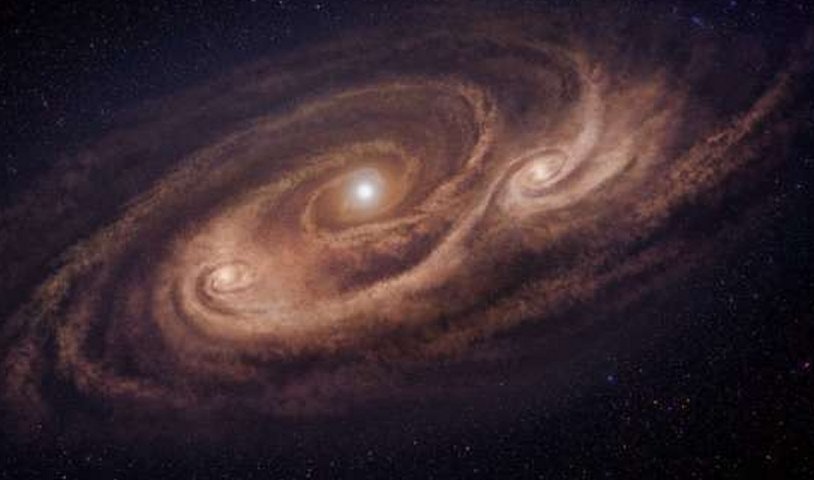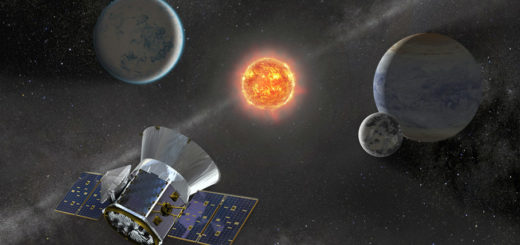New Study Reveals Some Of Ancient Secrets Of ‘Monster’ Star-Forming Galaxies
A “monster galaxy” 12.4 billion light years away has been studied by astronomers from Japan, Mexico and the University of Massachusetts Amherst, who observed the object in a 10 times higher angular resolution than ever before.

Artistic impression of the monster galaxy COSMOS-AzTEC-1. This galaxy is located 12.4 billion light-years away and is forming stars 1,000 times more rapidly than our Milky Way galaxy. ALMA observations revealed dense gas concentrations in the disk, and intense star formation in those concentrations. Credit: National Astronomical Observatory of Japan
Using the Atacama Large Millimeter/submillimeter Array (ALMA), astronomers obtained a series of completely unknown structural details that help to explain the formation process of massive, young “monster galaxies” (or extreme starburst galaxies) that came to existence only 1 billion years after the Big Bang.
These “monster galaxies” are believed to be ancestors of massive galaxies like the Milky Way in today’s universe. The observed starburst galaxy – nicknamed COSMOS-AzTEC-1 contributes with better understanding of their formation and evolution.
“A real surprise is that this galaxy seen almost 13 billion years ago has a massive, ordered gas disk that is in regular rotation instead of what we had expected, which would have been some kind of a disordered train wreck that most theoretical studies had predicted,” said Min Yun, professor of astronomy at UMass Amherst and a member of the team that discovered this galaxy using a UMass-built instrument named AzTEC in Chile in 2007.
Now it is known that this gas disk is dynamically unstable, which means the entire gas disk that makes up this galaxy is fragmenting and undergoing a gigantic episode of starburst, which helps to explain its enormous star formation rate, more than 1,000 times that of the Milky Way galaxy.
According to Ken-ichi Tadaki lead author of the study and researcher at the Japan Society for the Promotion of Science and the nation’s National Astronomical Observatory, COSMOS-AzTEC-1 is “rich in the ingredients of stars, but it was still difficult to figure out the nature of the cosmic gas in the galaxy…”
ALMA’s extraordinary capabilities (high resolution and high sensitivity to observe the galaxy) helped to create a detailed map of the distribution and the motion of the gas to make the highest resolution molecular gas map of a distant monster galaxy ever made.
“We found that there are two distinct large clouds several thousand light-years away from the center,” explained Tadaki. “In most distant starburst galaxies, stars are actively formed in the center. So it is surprising to find off-center clouds.”
There is still much to be observed regarding these galaxies as for example, how so much gas is collected so quickly and what kept this enormous gas reserve from igniting and turning into stars, as gas is known to do in the local universe,” Yun adds.
The astronomers also observed that the gas clouds in COSMOS-AzTEC-1 are very unstable, which is unusual. It has also been determined that the gas in COSMOS-AzTEC-1 will be completely consumed in 100 million years, which is 10 times faster than in other star forming galaxies.
Why the gas in COSMOS-AzTEC-1 is so unstable is not clear yet, but a phenomenon called “galaxy merger” is a possible cause.
Galaxy collision may have efficiently transported the gas into a small area and ignited intense star formation.
“At this moment, we have no evidence of merger in this galaxy. But by observing other similar galaxies with ALMA, we want to unveil the relation between galaxy mergers and monster galaxies,” Tadaki said.



 Creators of mankind
Creators of mankind Description of “Tall white aliens”
Description of “Tall white aliens” Where they came from?
Where they came from? About hostile civilizations
About hostile civilizations The war for the Earth
The war for the Earth “Tall white aliens” about eternal life
“Tall white aliens” about eternal life Video: “Nordic aliens”
Video: “Nordic aliens” Aliens
Aliens Alien encounters
Alien encounters The aliens base
The aliens base UFO
UFO Technology UFO
Technology UFO Underground civilization
Underground civilization Ancient alien artifacts
Ancient alien artifacts Military and UFO
Military and UFO Mysteries and hypotheses
Mysteries and hypotheses Scientific facts
Scientific facts


















